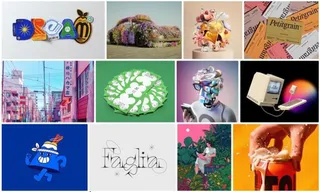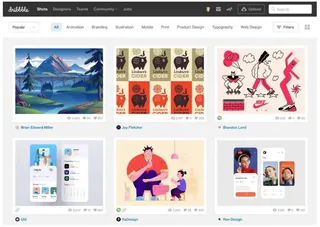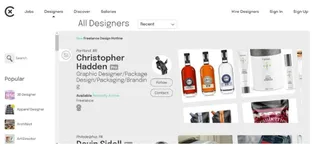Top Tips: Setting up your own Branding Portfolio Website


When taking your first steps towards working in the branding industry, the most important tool in any designer’s kit will be their online portfolio.
A great portfolio is a window into your world, your skills, and your experience, and is the perfect place for you to showcase your personality, talent, artistry, ideas, and best work to any potential employer.
While in the past a portfolio may have been a physical catalogue of your work, brand, web and graphic design work is now standardly hosted on a portfolio website and can now be made easily accessible to potential clients all over the world via the quick click of a button.
A well-executed and regularly updated portfolio gets your work in front of the right people and makes you look good in the process.
A brand design portfolio should be a curated showcase of your projects, case studies and ideas that present the most impressive and promising work to potential clients or employers.
They’re a point of introduction to your artistic style, personality, and professionalism.
Depending on the designer, the portfolio can include imagery from and links to live websites that they’ve worked on, sample projects, case studies, in-progress work, design mock-ups, and even smaller-scale branding assets such as logos, illustrations and typography design.
Clients will want to see your skills in all areas of branding to get a good idea of what you can do for them and their business.
While you can commit to building a website specifically for your portfolio, there are several free platforms out there that you can use to create yours without the financial and time commitment of launching a dedicated website.
There’s power in numbers, and unless you’re a veteran in the industry it pays to be a part of the design community where you can network with and take inspiration from your peers. Employers will also be on a time-saving mission, and you’re much more likely to be seen on one of these dedicated platforms than on your own standalone site.
On top of this, they tend to feature robust job listing platforms, where you can easily search for opportunities related to your specific skillset, or even post that you’re actively searching for a role.
Check out our favourites here:

Image source: Behance
Backed by Adobe, Behance is the go-to place for artists, graphic designers, photographers, videographers, and all other sorts of visual artists to showcase their best work and find inspiration when they need a lightbulb moment. With a massive community of 10 million members, users can share their designs and boost their network using the platform.
Designs are shown in detail via large photos, and users can even ask for feedback on their work from other designers. Another popular feature is the robust jobs listing portal relevant to all visual design careers featured on the site.
Recruiters and companies regularly use Behance to source the best talent out there, so it’s a fantastic place to make connections.

Image Source: Dribbble
Similar to Behance, Dribbble is a popular portfolio website that features work from global designers, illustrators, animators and more. While it offers users the chance to showcase their work amongst a large community of artists, it’s also known for its exclusivity and you can find some big names in the industry and some very high-quality work on the site.
One of its coolest features (one that sets it apart from its competitors) is that users can publish the projects they’re working on while in progress. This is a great way for other designers and potential employers to learn more about your creative style and how you tackle a project on a more granular level.
It’s also a great place to keep up to date on current design trends across branding, web design, icon design, animations, prototypes, illustrations, graphic art and much more.

Image source: Coroflot.com
Coroflot is one of the most popular design communities out there with more than 160,000 projects published every month by designers, photographers, illustrators, architects and more. You can also view top designers in any design category and find inspiration in their profiles.
It’s extremely simple to use whether you’re setting up a professional portfolio, looking to network, or browsing job listings. It’s also very user-friendly for anyone searching for a creative in a specific field or location, so you can be sure your portfolio won’t be missed.
It’s one of the best options if you’re specifically on the job hunt, as you can view salary insights within your field which you can potentially use to your advantage down the line when negotiating an offer.
As all of these websites are free to use, you can technically set up a portfolio on each, and simply share links to your other portfolios on your profile.
While you’d be missing out on the community aspect, another option is to try one of the many website builders out there that offer a range of stylish template designs specifically suited to portfolios, all for a reasonable fee. Industry favourites include Wix, Weebly, and Squarespace.
A portfolio is the visual representation of all you have accomplished so far. It gives an insight into, your true capabilities, allows you to create your design niche, and symbolises what you hope to achieve in the future. Having one is absolutely vital to success in today’s digital design landscape.
Whether you’re looking for an apprenticeship or work experience, a freelance contract or a full-time job in an agency, an up-to-date portfolio is the best way to show off your mouth-watering creative ideas and impressive design skills.
If you are hoping to land an agency role, visit Best Branding Agencies to Work for in the UK to know what to look for, and What is a Branding Agency to learn what you can expect once you’ve got your foot in the door.
Outside of any specific areas of expertise and potentially your location, it’s one the most important elements a client needs to see when on the hunt for a brand designer for their project. Without one, you’ll have immediately discounted yourself from the running.
Building your portfolio is a complex and often time-consuming but very important project in your early career as a brand designer.
Competition can be fierce, and anything that makes you stand out is a plus. To push your portfolio to the front, it helps to know what to include and what to leave out.
Follow our top tips to learn how to create a portfolio that’ll make an impact and start you on the road towards a successful, lucrative and rewarding career in brand design. As a Branding Agency in Manchester, we think we know what we're talking about : )
Now’s not the time to be shy or humble, you’ve got a finite amount of time to catch someone’s eye and demonstrate your talents, so make sure you’re showing off the work you’re most proud of.
Your portfolio website is like a living CV, and the content should make it clear to people what you can do. To keep things fresh, update it as often as possible.
If you can, add a wide variety of projects from a variety of sectors to showcase different industries you’ve worked in and your professional versatility.
Conversely, if you’re looking to mark yourself as a specialist in a certain industry or area, focusing on highlighting your work in a specific market niche can be highly beneficial and help any potential clients see instantly that you share a common industry and will be able to anticipate their preferences and professional requirements.
While a brand designer’s medium may not be words, your communication skills are just as paramount as the visuals you create.
Turning some of your favourite projects into a case study can be a great way to give the viewer an insight into your creative process.
Explain the brief, the requirements of the client, the problem, how you tackled it, the solution, and the end result. Demonstrating that you know each project like the back of your hand will give potential clients confidence that you will bring the same dedication and depth to their project. It also helps show off your problem-solving skills and gives a better sense of how you work — just be sure to underscore how you played the role of a problem-solver.
Aim to craft a story around each project. Humans connect with people and the stories they tell. Crafting a narrative around your work can entice potential clients and employers.
This doesn’t need to be long-winded but can add a new (and beneficial) dimension to your portfolio overall.
If you’re a student or recent graduate and are displaying some fictional case studies to demonstrate how you work, make this abundantly clear. Transparency is important you don’t want to be caught out for falsely representing yourself and your experiences further down the line.
It can be tempting to throw up every project and design you’ve ever worked on with the idea of showcasing your experience and breadth of skill, but less is more.
The average person doesn’t have the time to — nor will they want to — spend hours trawling through portfolios, and subsequently have to dig through yours to find your best work.
Impressions are formed instantly, so a small selection of quality should be front and centre. This way you’re still putting your best work out there, but it isn’t being diluted.
Around 10 projects are best, but to be sure take a look at some of the portfolios of designers you admire and see what looks and works best.
At its core, creativity is about originality, and your portfolio should be a place where you are truly and completely yourself (unless you’re a truly terrible person — keep that under wraps).
Standing out can be tough, and there’s a sea of talent on popular design portfolio websites, but incorporating your personality will make your portfolio truly unique. People hire people, not portfolios, and adding some information about yourself can really humanize your work.
When potential clients visit your site, they should be able to get a feel for who you are not only as a designer but as a human being. Showcasing your unique style and identity can go a long way in ensuring a client wants to work with you on their project.
Add personality by including a headshot (it’s always good to put a face to a name), and a bit about yourself, your experiences, and your services. They don’t need your life story but at least give a taste of the kind of person you are outside of design.
One guaranteed way to stand out, particularly in the brand design area, is to ensure your portfolio is created using memorable use of your own personal branding. Make your corner of the digital world your own by keeping your personal logo, colour usage, typography, and all visuals unique to you. It goes a long way when building credibility, as instantly proves you can ‘walk the walk’ and have a deep understanding of the power of branding overall.
On this note, be considered when using other portfolios for inspiration. It’s vitally important that your portfolio is a one-off, and copying someone else’s is a bad move all around — not least because it shows you lack original ideas.
The user experience should be at the forefront of your mind when putting your portfolio together, and the visit for any potential employer should be as enjoyable and simple as possible.
Make it clear what you can bring to a project, how you do it, and how they can reach you to discuss working together.
Make your contact details and any links to social accounts clear for any visitor to see, and ensure these are kept up to date. People won’t stick around if they’re struggling to even find the most basic information about you.
Your portfolio should maintain a crystal-clear intent, clearly show your objectives, and most of all be easy to navigate. Don’t shoot yourself in the foot by getting too creative. You’re looking to wow yes, but not bombard them with an overcomplicated page that’s a nightmare to use. Let your designs do the talking.
It’s also important to make sure a portfolio site works well across popular browsers and is mobile-friendly.
Use clean and simple layouts to let your work speak for itself and ensure the information you want people to see is easily accessible.
Make your contact details and any links to social accounts clear for any visitor to see and ensure these are kept up to date. People won’t stick around if they’re struggling to even find the most basic information about you.
People will hire you based on their connection with your brand design work and industry expertise, but it doesn’t hurt to let your past clients big you up.
As well as word-of-mouth recommendations, social proof is an excellent way to build trust and can help any potential clients get a taste of the kind of service and experience they can expect if they choose to work with you.
Be sure to collect testimonials from past clients as projects reach completion and store them either on a dedicated testimonials page within your portfolio or sprinkled throughout to ensure they’ve no chance of being missed.
In today’s world, less and less of our interactions with people and businesses take place face-to-face, and it’s successful branding that helps a brand to have a memorable and personable brand image.
Keeping a consistent brand image helps customers position and understand a business and makes it easier for them to remember and create positive associations with it.
No matter how good a product, any clued-up business owner will know the importance of smart, considered, and creative design to take their brand to the next level, and will be on the lookout for a talented brand designer to do so.
Follow our tips, get to work on your portfolio and you could be well on your way to launching a successful and long-term career in the exciting field of brand design.
If your portfolio works like a charm and a potential employer wants to chat, visit Interview Tips for Becoming a Brand Designer to learn how to make the best possible impression and get that contract or role you’ve been dreaming of.
Hello, I'm Natasia, and I'm a content writer for Shape.